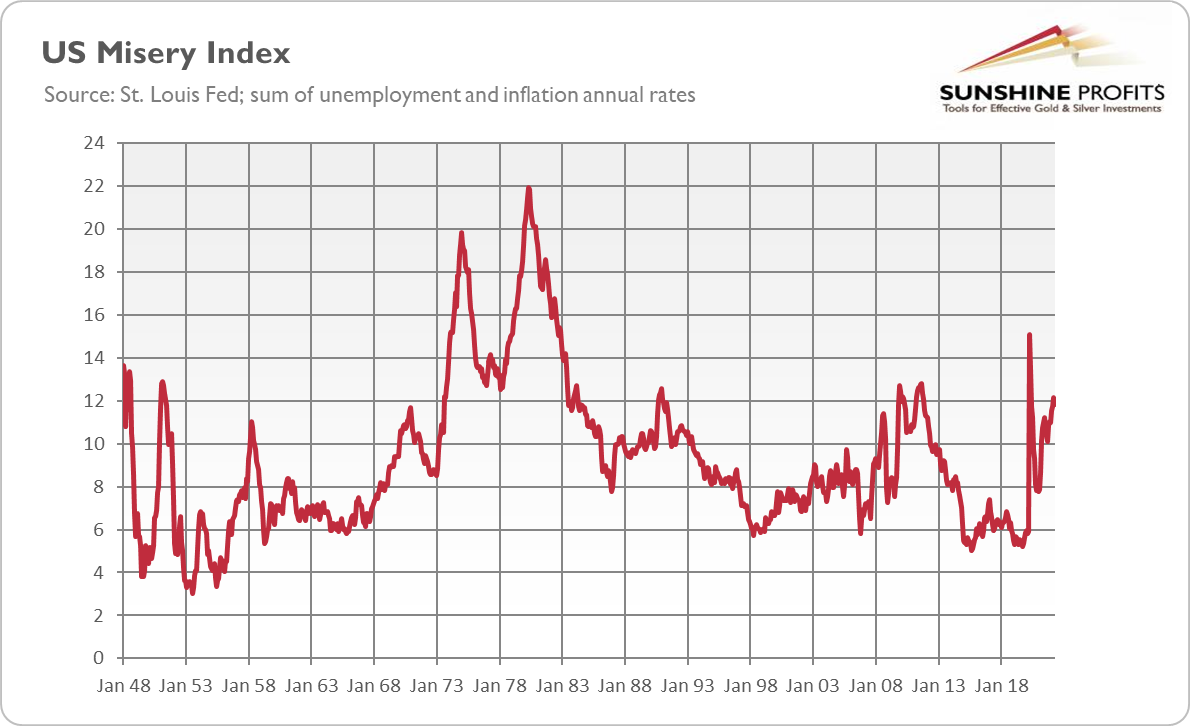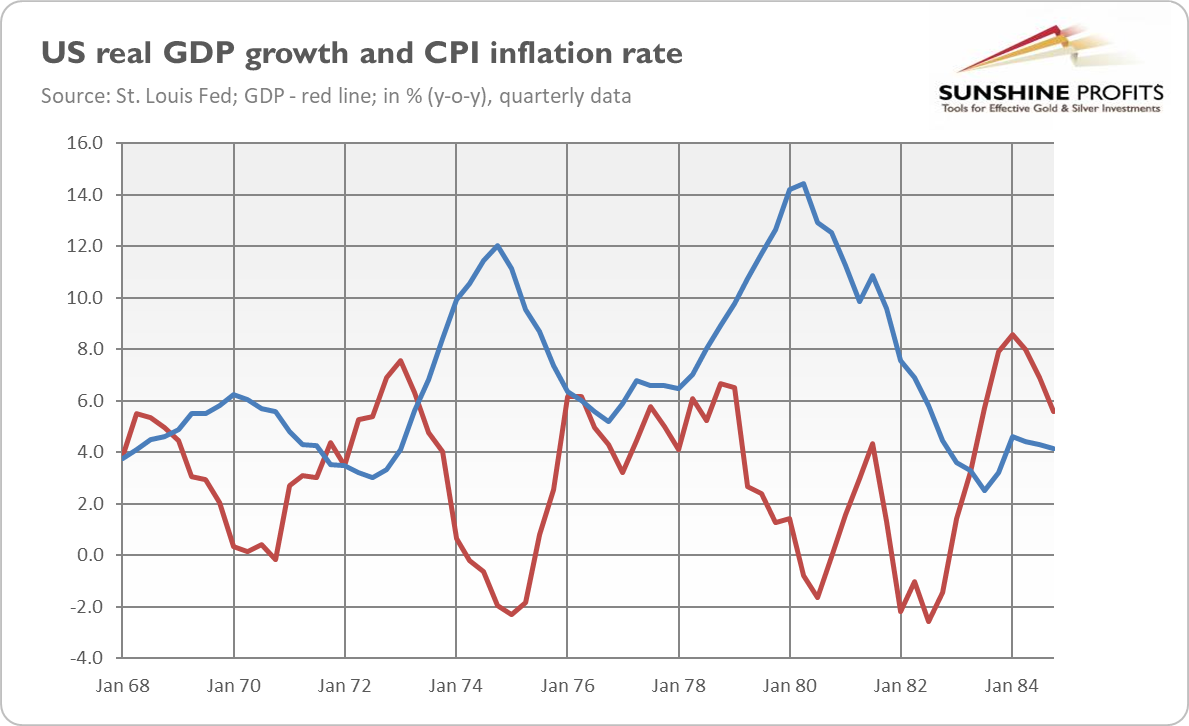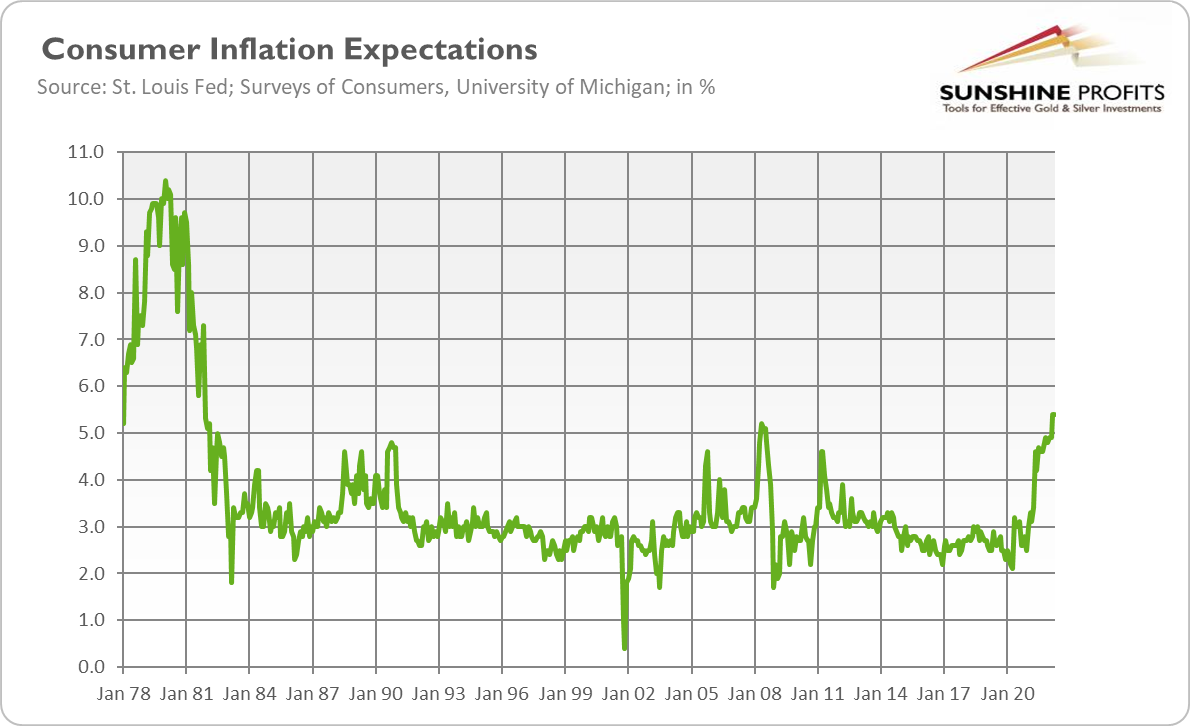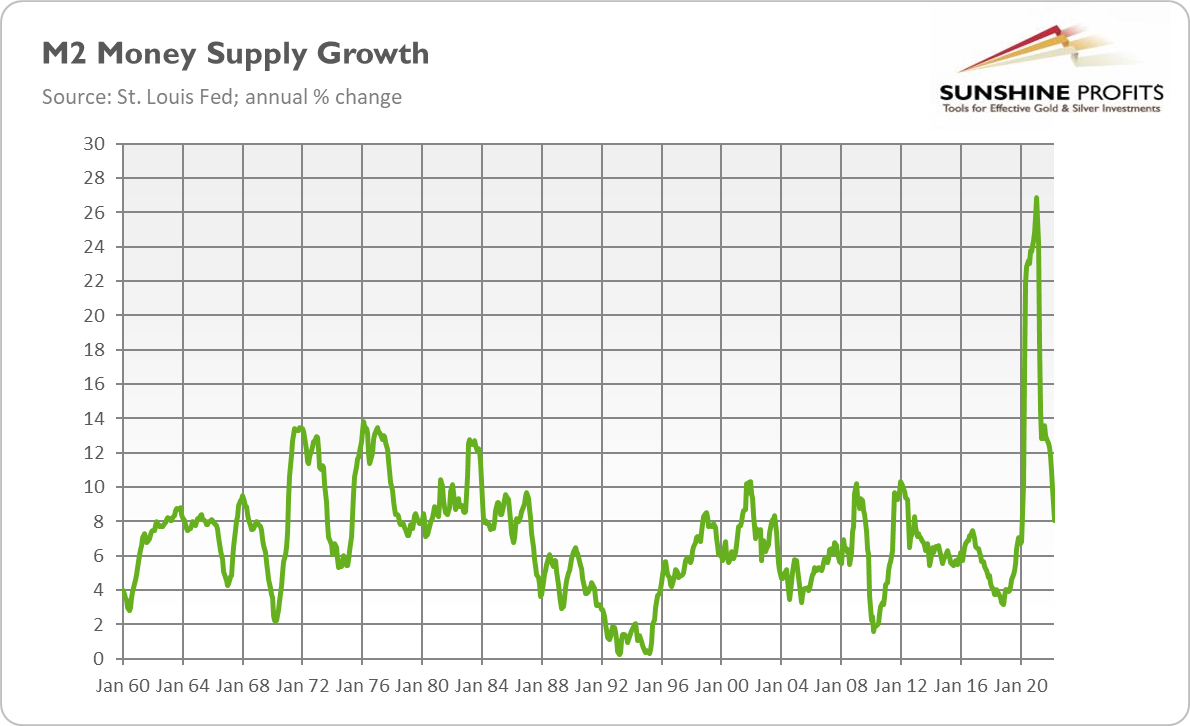The upcoming stagflation might be less severe than in the 1970s. So is the Fed’s reaction, which could mean good news for gold.
There are many terrifying statements you can hear from another person. One example is: “Honey, we need to talk!” Another is: “I’m from the government and I’m here to help.” However, the scariest English word, especially nowadays, is “stagflation.” Brrr!
I’ve explained it many times, but let me remind you that stagflation is a combination of economic stagnation and high inflation. This is why it’s a nightmare for central bankers as they should ease monetary policy to stimulate the economy and simultaneously tighten it to curb inflation.
Although we haven’t fallen into recession yet, the pace of GDP growth has slowed down recently. According to the World Bank’s report Global Economic Prospects from June 2022, “the global economy is in the midst of a sharp growth slowdown” and “growth over the next decade is expected to be considerably weaker than over the past two decades.” The U.S. growth is expected to slow to 2.5 percent in 2022, 1.2 percentage points lower than previously projected and 3.2 percentage points below growth in 2021.
This is why more and more experts raise concerns about stagflation similar to what happened in the 1970s. So far, employment remains strong, but the misery index, which is the sum of the unemployment rate and inflation rate, is already relatively high (see the chart below) and could continue to rise if economic activity deteriorates further.
So, it seems that the consensus view is that stagflation is likely, but the key question is how bad it will be, or how similar it will be to the stagflation of the 1970s. As the chart below shows, that period was pretty bad. The inflation rate stayed above 5% for a decade, reaching almost 15% in early 1980. Meanwhile, there was a long and deep recession in 1973-1975 and the subsequent two in the 1980s, triggered by Volcker’s monetary tightening that was necessary to curb high inflation.
Similarities are quite obvious. First, the economic slowdown came after the previous recession and rebound. Second, supply shocks. Supply disruptions caused by the pandemic and by Russia’s invasion of Ukraine resemble the oil shocks of the 1970s. Third, the burst of inflation comes after prolonged period of easy monetary policy and negative real interest rates. According to the World Bank, “global real interest rates averaged -0.5 percent over both the 1970-1980 and the 2010-2021 periods”. Fourth, consumer inflation expectations are rising significantly, which increases the risk of their de-anchoring, as in the 1970s. As the chart below shows, consumers now expect inflation to run at 5.4% over the next twelve months, according to the University of Michigan survey, the highest level since 1981.
However, the World Bank also points out important differences. First, the magnitude of commodity price jumps has been smaller than in the 1970s. Oil prices are still below the peaks from those years, especially in real terms, while the economy is much more energy-dependent. Second, the fiscal stance is tighter now. In the 1970s, fiscal policy was very easy, while now it’s expected to tighten, which could help to curb inflation. According to the CBO, the federal budget deficit will shrink to $1.0 trillion in 2022 from $2.8 trillion last year.
Third, the M2 money stock M2 ballooned after the pandemic by 40% in just two years. So, the increase in the money supply was much more abrupt, although it was rather a one-time outburst than a constant fast pace of money supply growth as it was in the 1970s (see the chart below). Thus, the pattern of inflation could be similar.
Fourth, contemporary economies are much more flexible with the weaker position of trade unions, and income and price policies (like interest or price controls) are not popular today. It allows a faster response of supply to rising prices and reduces the likelihood of price-wage spirals. The fifth difference mentioned by the World Bank is more credible monetary policy frameworks and better-anchored inflation expectations. Although true, I would be cautious here, as the Fed remains behind the curve and people could quickly lose confidence in the central bank while inflation expectations could easily de-anchor.
For me, the two crucial differences are the much higher levels of both private and public debt today compared to the 1970s (see the chart below) and less political willingness to combat inflation. Yes, Powell could have a laser focus on addressing inflation right now, but I seriously doubt whether he will stick with significantly raising interest rates, especially when the economy starts to falter.
So, what are the conclusions and implications for the gold market? Well, stagflation is indeed likely, as I expect a further economic slowdown next year, which will be accompanied by stubbornly elevated inflation, although rather lower than this year, thanks to normalization in the pace of money supply growth and tightening of both monetary and fiscal policies. Hence, the upcoming stagflation could be less severe than in the 1970s.
The Fed’s response will also be less aggressive. Luckily for the yellow metal, Powell is not Volcker, so he won’t raise the federal funds rate so decisively. Hence, the current Fed’s tightening cycle could continue to exert downward pressure on gold. However, when the Fed chickens out and deviates from its hawkish plan when faced with recessionary winds, gold should rally again.
All essays, research and information found above represent analyses and opinions of Przemyslaw Radomski, CFA and Sunshine Profits' employees and associates only. As such, it may prove wrong and be a subject to change without notice. Opinions and analyses were based on data available to authors of respective essays at the time of writing. Although the information provided above is based on careful research and sources that are believed to be accurate, Przemyslaw Radomski, CFA and his associates do not guarantee the accuracy or thoroughness of the data or information reported. The opinions published above are neither an offer nor a recommendation to purchase or sell any securities. Mr. Radomski is not a Registered Securities Advisor. By reading Przemyslaw Radomski's, CFA reports you fully agree that he will not be held responsible or liable for any decisions you make regarding any information provided in these reports. Investing, trading and speculation in any financial markets may involve high risk of loss. Przemyslaw Radomski, CFA, Sunshine Profits' employees and affiliates as well as members of their families may have a short or long position in any securities, including those mentioned in any of the reports or essays, and may make additional purchases and/or sales of those securities without notice.
Recommended Content
Editors’ Picks
USD/JPY holds near 155.50 after Tokyo CPI inflation eases more than expected

USD/JPY is trading tightly just below the 156.00 handle, hugging multi-year highs as the Yen continues to deflate. The pair is trading into 30-plus year highs, and bullish momentum is targeting all-time record bids beyond 160.00, a price level the pair hasn’t reached since 1990.
AUD/USD stands firm above 0.6500 with markets bracing for Aussie PPI, US inflation

The Aussie Dollar begins Friday’s Asian session on the right foot against the Greenback after posting gains of 0.33% on Thursday. The AUD/USD advance was sponsored by a United States report showing the economy is growing below estimates while inflation picked up.
Gold soars as US economic woes and inflation fears grip investors

Gold prices advanced modestly during Thursday’s North American session, gaining more than 0.5% following the release of crucial economic data from the United States. GDP figures for the first quarter of 2024 missed estimates, increasing speculation that the US Fed could lower borrowing costs.
FBI cautions against non-KYC Bitcoin and crypto money transmitting services as SEC goes after MetaMask

US FBI has issued a caution to Bitcoiners and cryptocurrency market enthusiasts, coming on the same day as when the US Securities and Exchange Commission is on the receiving end of a lawsuit, with a new player adding to the list of parties calling for the regulator to restrain its hand.
Bank of Japan expected to keep interest rates on hold after landmark hike

The Bank of Japan is set to leave its short-term rate target unchanged in the range between 0% and 0.1% on Friday, following the conclusion of its two-day monetary policy review meeting for April. The BoJ will announce its decision on Friday at around 3:00 GMT.




